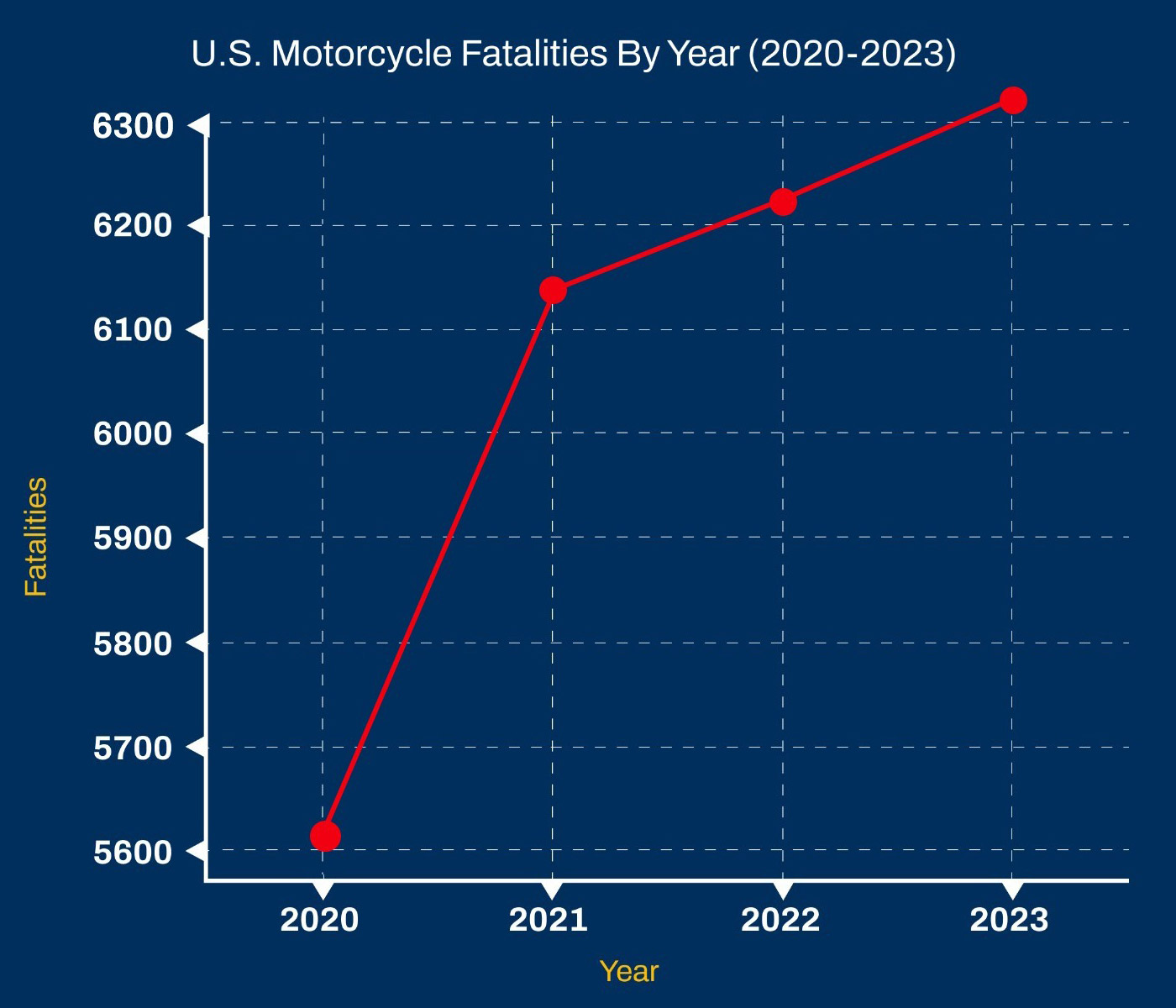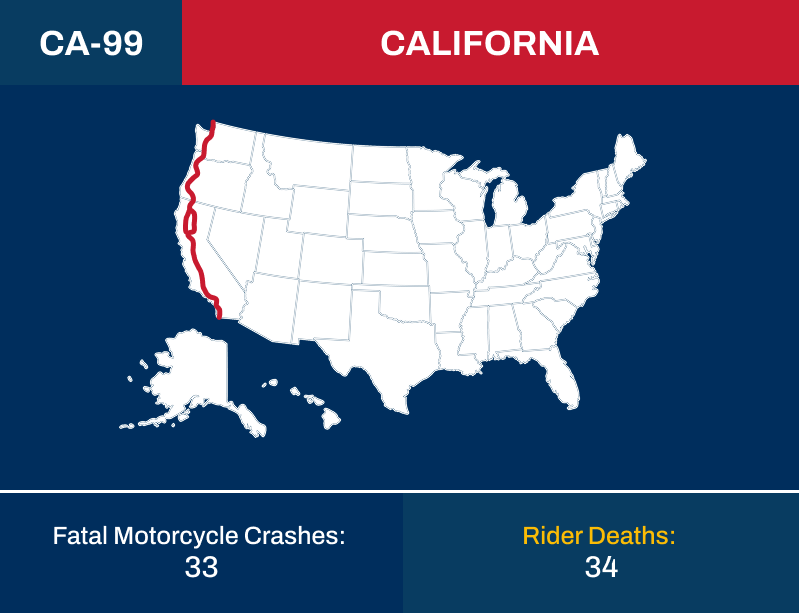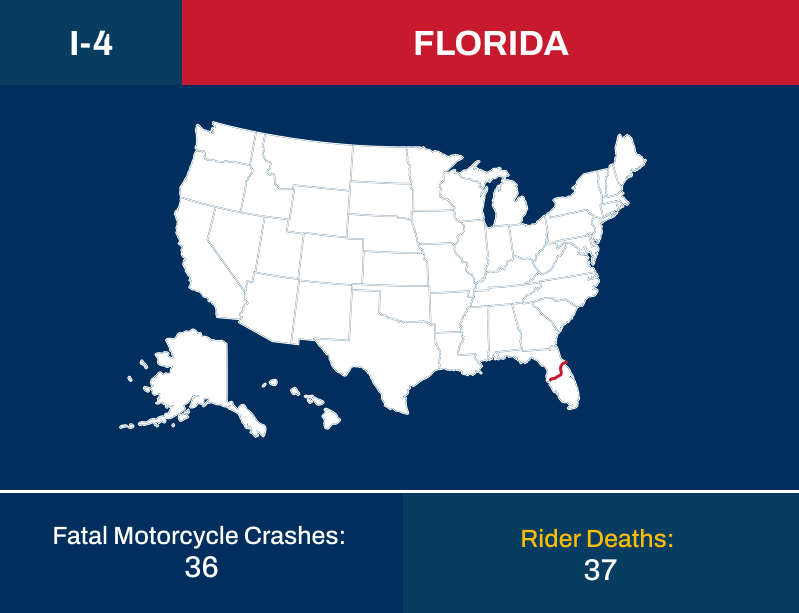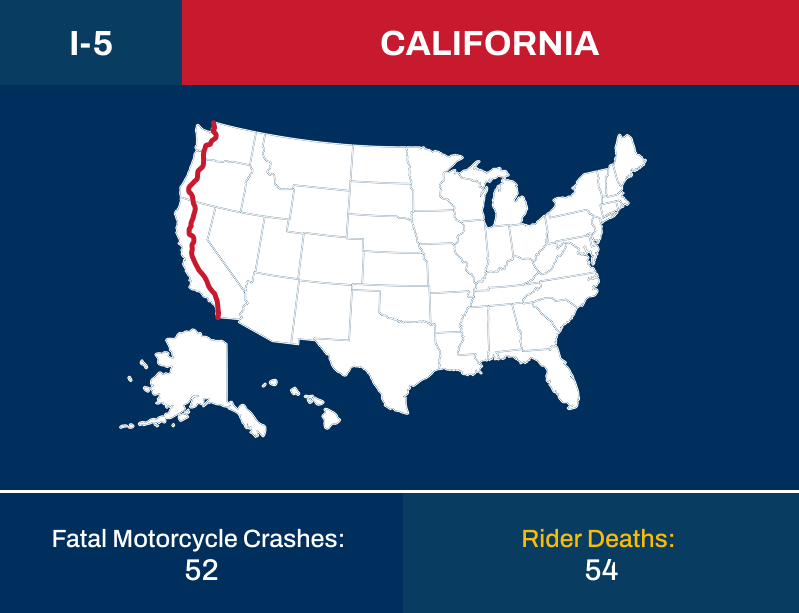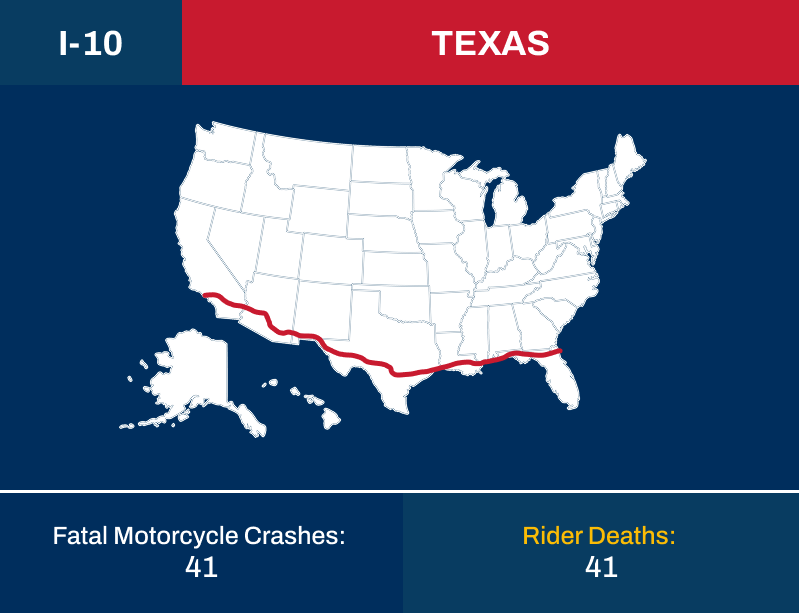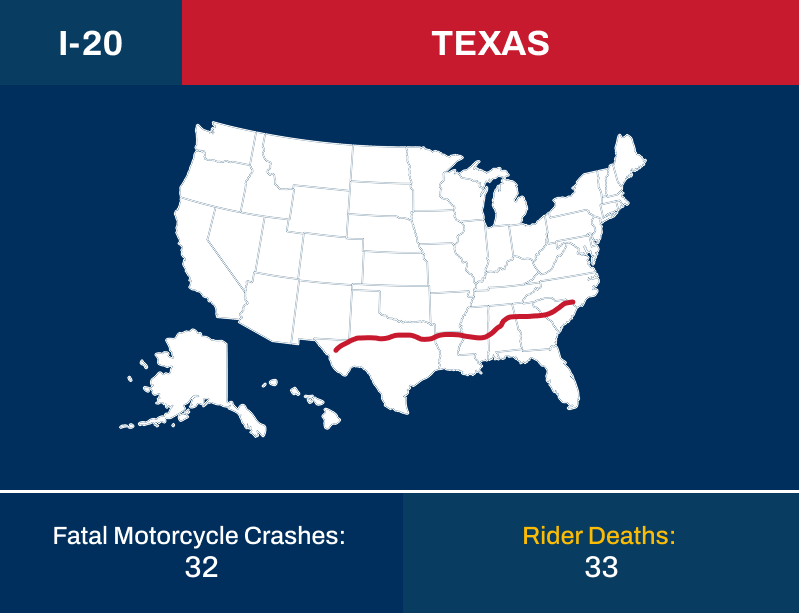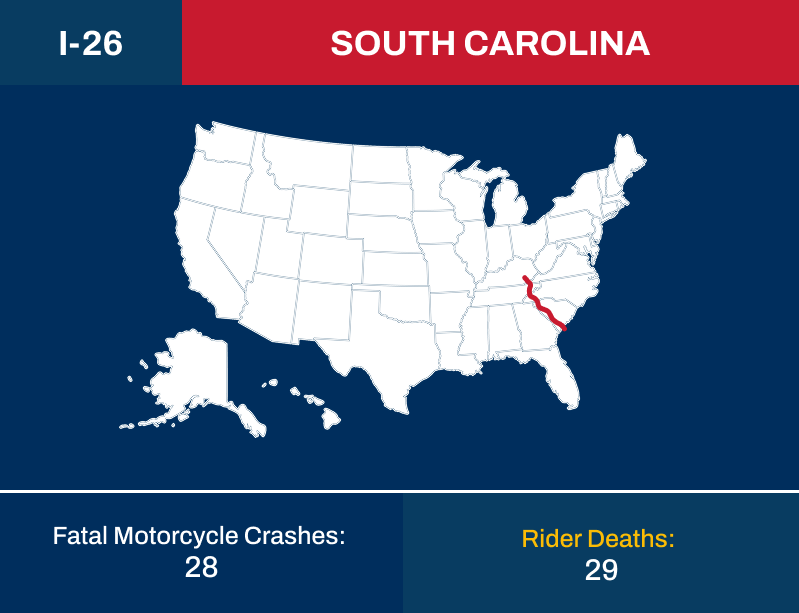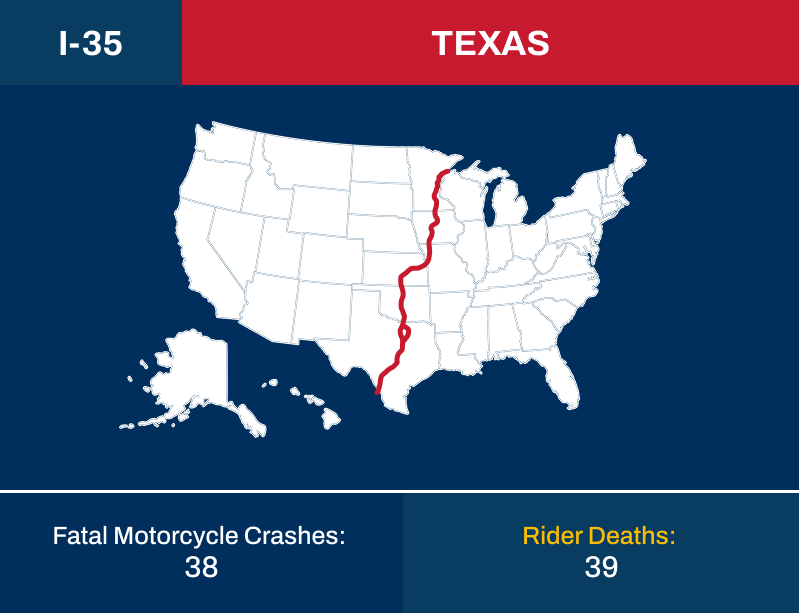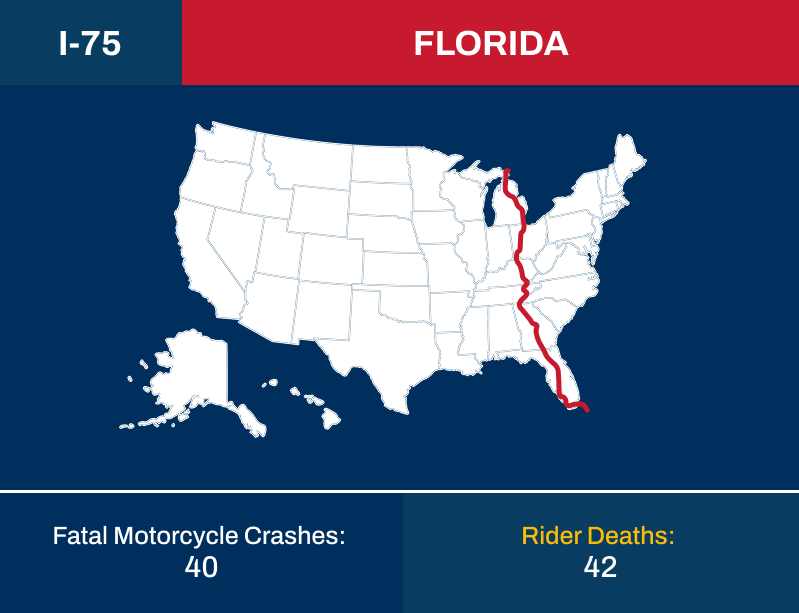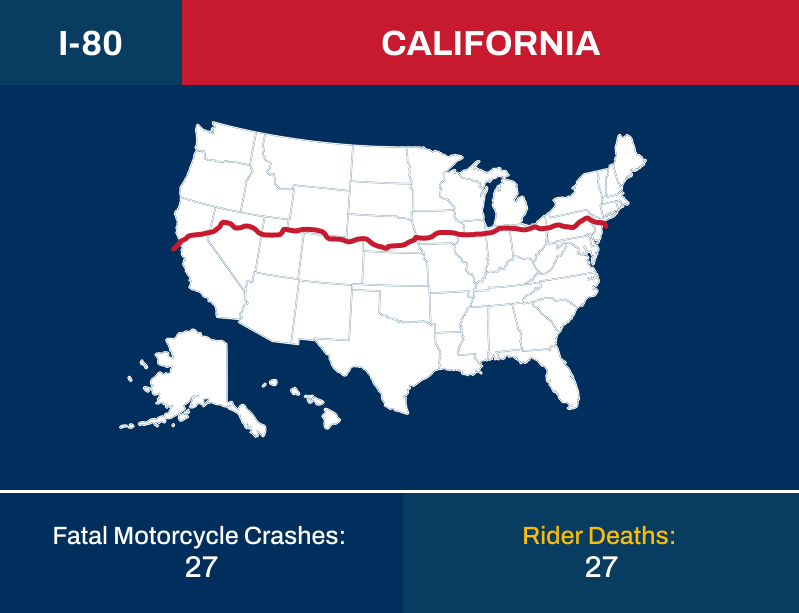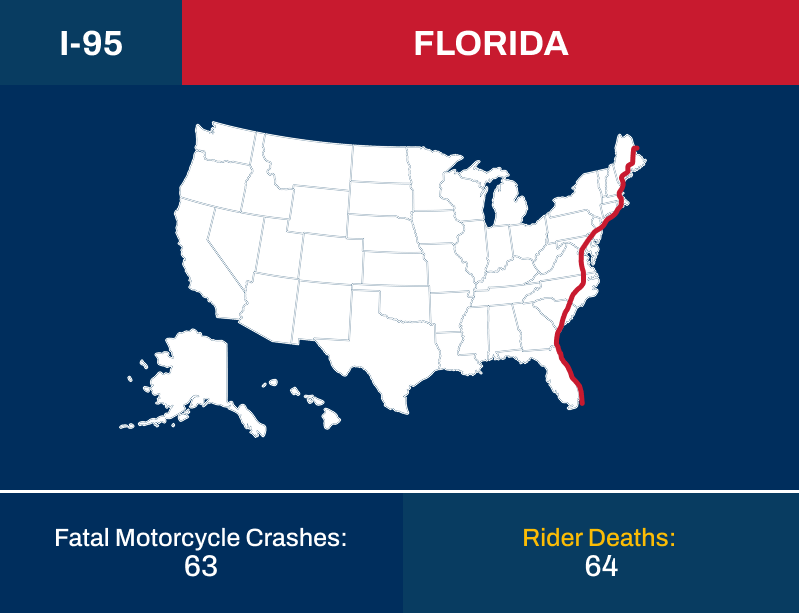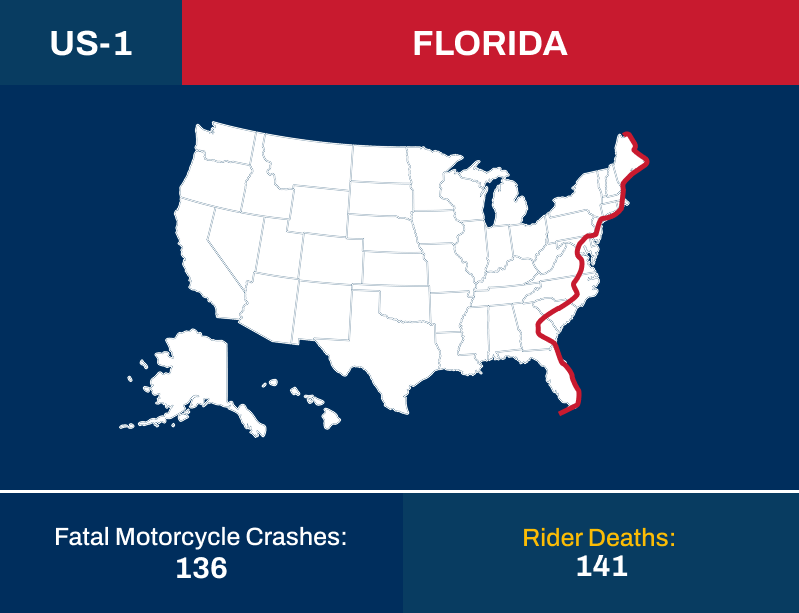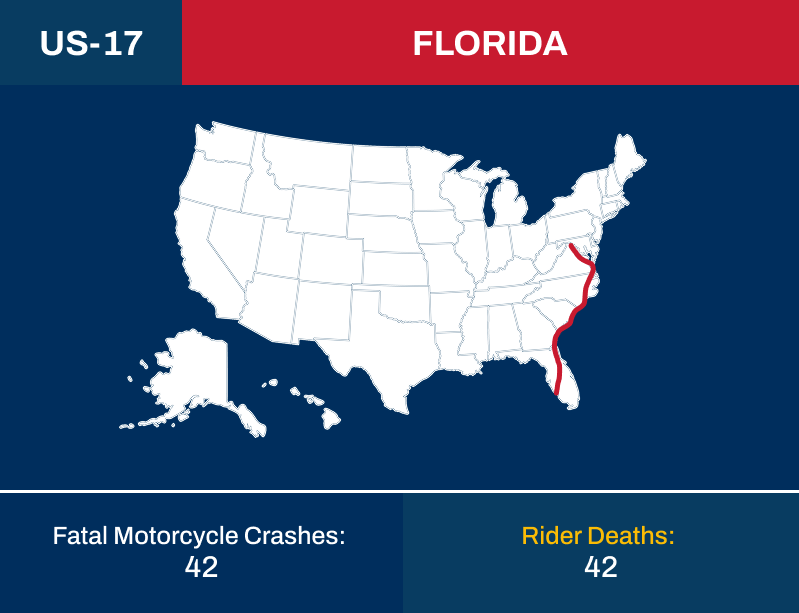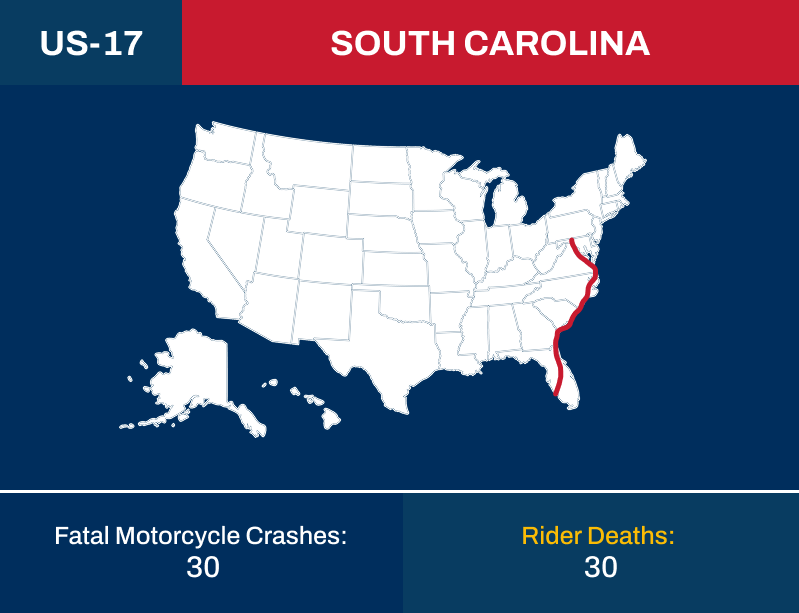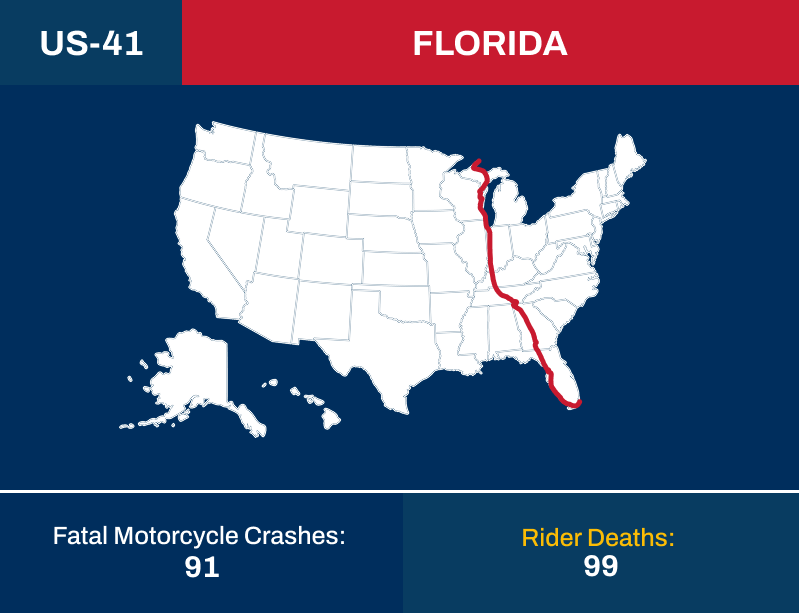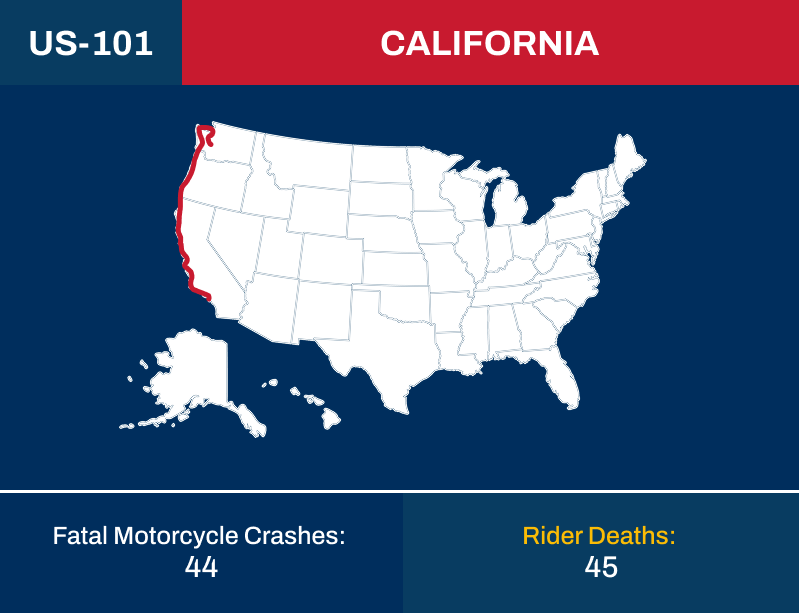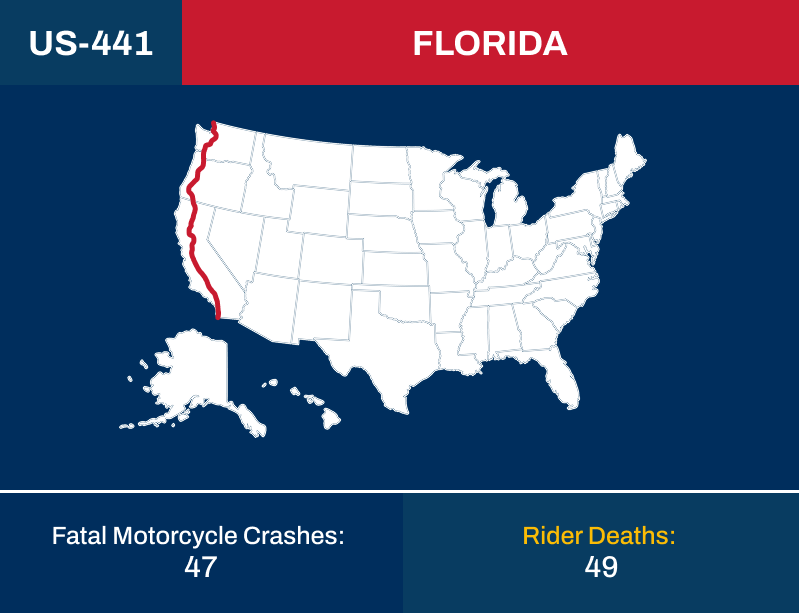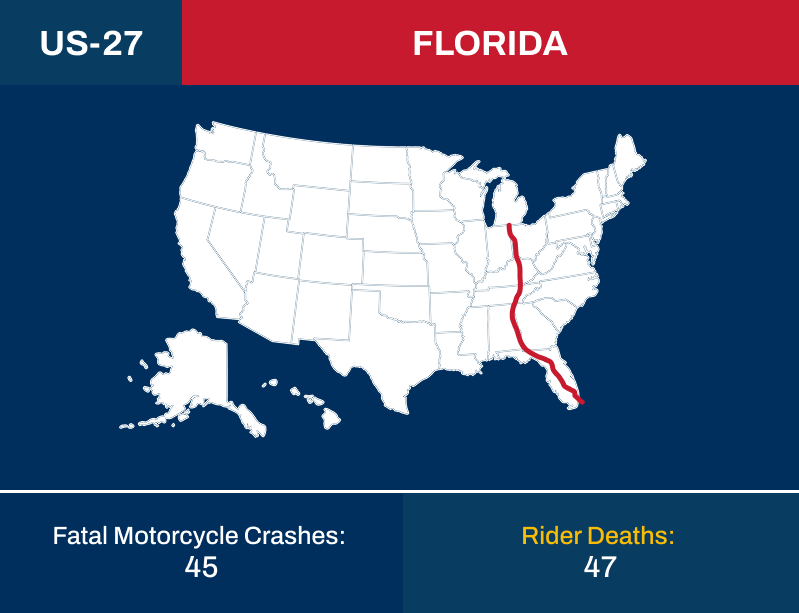Every time you ride a motorcycle, you take a risk. But do you know which highways are the deadliest for motorcyclists in America?
Between 2020 and 2024, thousands of riders lost their lives on U.S. highways. Our study analyzes five years of crash data, highlighting the most dangerous roads, key risk factors, and alarming trends that every rider needs to know.
At Trantolo & Trantolo, we believe that knowledge is power. That’s why we created this case study to help you understand the most serious hazards facing motorcyclists—and how to fight back when accidents happen. What you’ll find in this study:
✔️ National motorcycle fatality trends & contributing factors – Are crashes becoming more deadly?
✔️ The 50 deadliest highways for motorcyclists – Where are riders most at risk?
✔️ Top states with the most motorcycle crash deaths – Who leads the nation?
✔️ Top causes of motorcycle crashes on high-risk highways – What common mistakes and road conditions lead to deadly outcomes?
✔️ Urban vs. rural highways – Where are motorcycle deaths more common?
✔️ Helmet laws and other laws for motorcyclists – How much protection do riders have?
✔️ Legal rights for injured riders – What to do if you’ve been hit
If you or a loved one has been injured in a motorcycle accident, don’t fight solo. Call Trantolo & Trantolo to see how our Connecticut motorycle accident lawyers can help you.
Motorcycle Crash Trends & Contributing Factors: Rising Danger for U.S. Riders
Motorcyclist fatalities have shown a steady and concerning increase from 2020 to 2023. In 2020, there were 5,620 fatalities, rising to 6,335 by 2023—an overall increase of approximately 12.72%.
This upward trend highlights persistent safety challenges for motorcyclists, underscoring the urgent need for stronger enforcement of helmet laws, improved rider education, and infrastructure upgrades to better protect vulnerable road users.
National Motorcycle Fatalities by Year:
| 2020 | 5,620 motorcyclist fatalities |
| 2021 | 6,143 motorcyclist fatalities |
| 2022 | 6,218 motorcyclist fatalities |
| 2023 | 6,335 motorcyclist fatalities |
| 2024 | Specific data for 2024 is not yet available |
While some states like Florida reported slight declines in fatalities by 2024, others, including Texas, continued to see persistently high numbers. The data clearly show that fatalities are not randomly distributed but concentrated in specific states, environments, and road types.
Southern states with year-round riding weather, weaker helmet laws, and high-speed highways account for a disproportionate share of deaths. Road design, impaired driving, poor lighting, and event-related surges (like Bike Week or Sturgis) further compound the danger. Without significant intervention—through improved infrastructure, stronger safety laws, and public awareness campaigns—these same deadly patterns will continue, making rider safety a pressing public health issue across the U.S.
Top 50 Deadliest Highways for Motorcyclists (2020–2024)
We analyzed crash statistics, state DOT data, and national traffic studies to identify the highways with the highest number of fatal motorcycle crashes over five years.
| I-80 (California) | |
|---|---|
| Fatal Motorcycle Crashes | 27 crashes |
| Rider Deaths | 27 |
| Overview | Crosses the Bay Area through Sacramento to the Sierra Nevada |
| Risk Factors | Urban congestion, mountain weather, rapid elevation shifts |
| Trend (2020–2024) | Moderate but persistent motorcycle deaths, especially in winter months and near urban interchanges. |
| I-75 (Georgia) | |
|---|---|
| Fatal Motorcycle Crashes | 26 crashes |
| Rider Deaths | 26 |
| Overview | Runs through metro Atlanta with a deadly section known as the “Downtown Connector” |
| Risk Factors | Rear-end crashes, speed variance, high traffic density |
| Trend (2020–2024) | Despite universal helmet law, crash rates remain high due to Atlanta’s volume and unpredictable traffic flow. |
| I-85 (Georgia/North Carolina) | |
|---|---|
| Fatal Motorcycle Crashes | 25 crashes |
| Rider Deaths | 25 |
| Overview | Busy multi-state corridor connecting two major metro areas: Atlanta and Charlotte |
| Risk Factors | Congestion, aggressive drivers, wet roads |
| Trend | Multiple biker deaths reported each year in both states. Fatalities skew higher near urban exits. |
| US-98 (Florida) | |
|---|---|
| Fatal Motorcycle Crashes | 24 crashes |
| Rider Deaths | 24 |
| Overview | Scenic highway along the Panhandle and Gulf Coast |
| Risk Factors | Tourist traffic, poor visibility, beach access roads |
| Trend | Frequent seasonal fatalities—especially between March and August. |
| I-95 (Georgia/South Carolina) | |
|---|---|
| Fatal Motorcycle Crashes | 24 crashes |
| Rider Deaths | 24 |
| Overview | Continues north from Florida, passing through rural areas and travel corridors |
| Risk Factors | Fatigue, high-speed travel, long-distance riding |
| Trend | Despite federal safety funds and improvements, I-95 remains in top crash data for both states. |
| I-10 (Arizona) | |
|---|---|
| Fatal Motorcycle Crashes | 23 crashes |
| Rider Deaths | 23 |
| Overview | Phoenix to Tucson corridor, one of the busiest in the Southwest |
| Risk Factors | Desert heat, tire failures, dense traffic |
| Trend | Rider deaths remain high year after year. Arizona ranks among the top 10 states for per capita biker deaths. |
| I-17 (Arizona) | |
|---|---|
| Fatal Motorcycle Crashes | 22 crashes |
| Rider Deaths | 22 |
| Overview | Winding route from Phoenix to Flagstaff through mountainous terrain |
| Risk Factors | Sharp turns, steep grades, heat exhaustion |
| Trend | Spikes in summer crashes. Often involves solo or curve-related incidents. |
| I-405 (California) | |
|---|---|
| Fatal Motorcycle Crashes | 21 crashes |
| Rider Deaths | 21 |
| Overview | L.A.’s most congested freeway, high motorcycle volume due to legal lane-splitting |
| Risk Factors | Stop-and-go congestion, distracted drivers, abrupt lane changes |
| Trend | Dozens of annual fatalities despite lower per-mile death rate. Minor collisions are common. |
| Angeles Crest Highway (CA-2, California) | |
|---|---|
| Fatal Motorcycle Crashes | 20 crashes |
| Rider Deaths | 20 |
| Overview | Winding mountain road in Los Angeles County |
| Risk Factors | Sharp corners, no guardrails, steep drops |
| Trend | Solo wrecks dominate the stats; remains notoriously dangerous for sport bikers and weekend riders. |
| Ortega Highway (CA-74, California) | |
|---|---|
| Fatal Motorcycle Crashes | 16 crashes |
| Rider Deaths | 16 |
| Overview | Curvy route from Orange County to Lake Elsinore |
| Risk Factors | Blind turns, head-on risks, inexperienced riders |
| Trend | Safety efforts haven’t curbed deaths. Still popular with sport riders despite warnings. |
| Blue Ridge Parkway (North Carolina/Virginia) | |
|---|---|
| Fatal Motorcycle Crashes | 15 crashes |
| Rider Deaths | 15 |
| Overview | Scenic national route through the Appalachians |
| Risk Factors | Wet curves, wildlife, limited visibility |
| Trend | Rider deaths remain consistent each year—usually single-bike crashes in poor weather or on blind turns. |
| CA-1 (Pacific Coast Highway, California) | |
|---|---|
| Fatal Motorcycle Crashes | 34 crashes |
| Rider Deaths | 34 |
| Overview | Famous for its cliffside views and ocean curves, this scenic highway poses |
| Risk Factors | major hazards with tight turns and distracted tourist drivers |
| Trend | Remains high-risk, especially in Monterey, Big Sur, and Malibu. Frequent fatal crashes in summer and weekends. |
| I-30 (Texas/Arkansas) | |
|---|---|
| Fatal Motorcycle Crashes | 33 crashes |
| Rider Deaths | 34 |
| Overview | Stretching from Fort Worth through Dallas and into Arkansas, this route sees |
| Risk Factors | fast-moving traffic and frequent multi-vehicle crashes |
| Trend | Fatality rate increasing due to suburban growth and speeding. |
| I-8 (California/Arizona) | |
|---|---|
| Fatal Motorcycle Crashes | 31 crashes |
| Rider Deaths | 31 |
| Overview | Runs from San Diego to Arizona’s deserts. Straight desert stretches create risk from fatigue and heatstroke |
| Risk Factors | Fatigue, heatstroke |
| Trend | Fatalities remain steady. Summer months see a spike in single-rider crashes. |
| US-60 (Arizona/New Mexico) | |
|---|---|
| Fatal Motorcycle Crashes | 29 crashes |
| Rider Deaths | 30 |
| Overview | A desert and mountain highway popular with scenic riders. Sharp elevation changes and winding passes increase crash risk |
| Risk Factors | Sharp elevation changes, winding passes |
| Trend | Persistent danger for weekend riders and tourists, especially near Globe, AZ. |
| I-64 (Kentucky/West Virginia/Virginia) | |
|---|---|
| Fatal Motorcycle Crashes | 27 crashes |
| Rider Deaths | 28 |
| Overview | A mid-Appalachian route with tricky terrain and weather changes. Curvy sections and wet roads create peril |
| Risk Factors | Tricky terrain, wet roads, curves |
| Trend | Fatalities vary year to year but remain above national average per mile. |
| US-95 (Nevada/Arizona) | |
|---|---|
| Fatal Motorcycle Crashes | 26 crashes |
| Rider Deaths | 26 |
| Overview | Known for long desert stretches and high-speed traffic. Especially dangerous near Las Vegas |
| Risk Factors | Desert stretches, high-speed traffic |
| Trend | Spike in fatalities since 2021, often tied to high-speed solo wrecks. |
| I-81 (Virginia/Pennsylvania) | |
|---|---|
| Fatal Motorcycle Crashes | 25 crashes |
| Rider Deaths | 25 |
| Overview | A freight-heavy interstate in the Appalachian corridor. Truck traffic and foggy conditions are frequent |
| Risk Factors | Truck traffic, fog |
| Trend | Moderate but consistent fatality levels from 2020–2024. Virginia and Pennsylvania have launched awareness campaigns. |
| US-70 (North Carolina/Tennessee) | |
|---|---|
| Fatal Motorcycle Crashes | 24 crashes |
| Rider Deaths | 24 |
| Overview | Includes rural curves and urban sprawl near cities like Asheville and Knoxville |
| Risk Factors | Blind corners, limited lighting in rural areas |
| Trend | Remains a high-risk highway due to blind corners and limited lighting in rural areas. |
| I-49 (Louisiana/Arkansas) | |
|---|---|
| Fatal Motorcycle Crashes | 23 crashes |
| Rider Deaths | 23 |
| Overview | Runs through Shreveport and Alexandria with a mix of urban interchanges and rural stretches |
| Risk Factors | Construction zones, wet weather |
| Trend | Rising fatality trend since 2021, especially in construction zones and wet weather. |
| US-50 (Nevada/California) | |
|---|---|
| Fatal Motorcycle Crashes | 22 crashes |
| Rider Deaths | 22 |
| Overview | Known as “The Loneliest Road in America,” its remote location and high-speed stretches are attractive but dangerous to riders |
| Risk Factors | Remoteness, high-speed stretches, delayed medical response |
| Trend | Fatalities spike during peak summer travel. Medical response delays contribute to death rate. |
| I-70 (Colorado/Kansas/Missouri) | |
|---|---|
| Fatal Motorcycle Crashes | 21 crashes |
| Rider Deaths | 21 |
| Overview | From Denver through the Midwest, this major corridor presents shifting terrain, weather extremes, and high-speed travel |
| Risk Factors | Shifting terrain, weather extremes, traffic surges |
| Trend | Rider deaths have increased near Denver and Kansas City due to traffic surges and poor visibility. |
| US-301 (Florida/Maryland) | |
|---|---|
| Fatal Motorcycle Crashes | 20 crashes |
| Rider Deaths | 20 |
| Overview | A heavily trafficked corridor through small towns and suburban areas. Intersections and merging zones are high-risk |
| Risk Factors | Intersections, merging zones, high traffic volume |
| Trend | Crashes remain frequent, especially in central Florida and southern Maryland. |
| US-441 (Georgia/North Carolina) | |
|---|---|
| Fatal Motorcycle Crashes | 19 crashes |
| Rider Deaths | 20 |
| Overview | Winding mountain roads and tourist traffic through the Smoky Mountains and rural Georgia |
| Risk Factors | Scenic overlooks, weekend rider density |
| Trend | Weekend rider deaths continue to climb, especially near scenic overlooks. |
| US-82 (Texas/Mississippi) | |
|---|---|
| Fatal Motorcycle Crashes | 18 crashes |
| Rider Deaths | 19 |
| Overview | This east-west corridor spans rural farmland, with fast traffic and limited shoulders |
| Risk Factors | Rural speeding, limited shoulders |
| Trend | Fatalities increased with higher rural speeding trends since 2021. |
| I-44 (Missouri/Oklahoma) | |
|---|---|
| Fatal Motorcycle Crashes | 18 crashes |
| Rider Deaths | 18 |
| Overview | Connecting St. Louis and Oklahoma City, I-44 carries dense truck and commuter traffic with inconsistent road conditions |
| Risk Factors | Truck traffic, inconsistent road conditions |
| Trend | Motorcycle deaths stable but elevated in urban zones and weather-prone areas. |
| US-90 (Texas/Louisiana) | |
|---|---|
| Fatal Motorcycle Crashes | 17 crashes |
| Rider Deaths | 18 |
| Overview | A Gulf Coast route with varying speed limits, rail crossings, and flood-prone areas |
| Risk Factors | Rainstorms, hurricanes, rail crossings |
| Trend | Frequent rider deaths during rainstorms and hurricane season. |
| I-59 (Mississippi/Alabama) | |
|---|---|
| Fatal Motorcycle Crashes | 17 crashes |
| Rider Deaths | 17 |
| Overview | Hilly, forested sections and rural interchanges make this route deceptively risky |
| Risk Factors | Forest terrain, rural interchanges |
| Trend | Fatality rates are trending upward, especially in northeast Alabama. |
| US-395 (California/Nevada) | |
|---|---|
| Fatal Motorcycle Crashes | 16 crashes |
| Rider Deaths | 17 |
| Overview | Runs from SoCal through the Eastern Sierra, is popular with long-distance riders. Fast rural stretches pose major hazards |
| Risk Factors | Fast rural stretches, seasonal travel |
| Trend | Deadly summer and fall seasons, especially around Bishop and Mammoth. |
| I-380 (Pennsylvania) | |
|---|---|
| Fatal Motorcycle Crashes | 16 crashes |
| Rider Deaths | 16 |
| Overview | Short but deadly connector in the Poconos with fast curves and changing elevations |
| Risk Factors | Fast curves, elevation changes |
| Trend | Despite relatively low traffic volume, crash severity is high—especially among solo riders. |
| Natchez Trace Parkway (Mississippi/Tennessee) | |
|---|---|
| Fatal Motorcycle Crashes | 15 crashes |
| Rider Deaths | 15 |
| Overview | Scenic and historic route with minimal commercial traffic but numerous curves and wildlife crossings |
| Risk Factors | Curves, wildlife crossings, scenic distractions |
| Trend | Consistently ranks as one of the deadliest national park roads for bikers, especially during peak riding seasons. |
States with the Highest Motorcycle Fatality Risk in 2023
Motorcycle fatalities remain a serious concern across the United States, with some states reporting significantly higher numbers than others.
| State | Fatalities |
|---|---|
| Florida | 668 |
| Texas | 598 |
| California | 583 |
| Arizona | 257 |
| Pennsylvania | 240 |
The following states have emerged as the most dangerous for motorcyclists, based on recent fatality data, highlighting the urgent need for increased awareness, better infrastructure, and stronger safety measures.
Florida
Why It’s High-Risk:
- Most entries are in the top 50 deadliest highways (7 in the top 10).
- Year-round riding weather increases exposure.
- Partial helmet law: Riders 21+ can ride without a helmet if insured.
- High-speed, high-traffic interstates like I-95, I-75, US-1, and US-19.
- Tourist traffic and major events (e.g., Daytona Bike Week) increase crash rates.
- Sudden storms and poor lighting are common in many areas.
Texas
Why It’s High-Risk:
- Extensive highway network with deadly routes like I-10, I-20, I-35, and US-281.
- Year-round riding climate and a large biker population.
- Partial helmet law and high rates of impaired driving.
- High-speed limits (up to 85 mph) and rural stretches with limited emergency response.
- Frequent fatal crashes in urban hubs (Houston, Dallas, Austin).
California
Why It’s High-Risk:
- High volume of riders and congested urban corridors (e.g., I-5, I-405, US-101).
- Iconic but hazardous scenic roads like CA-2 (Angeles Crest) and CA-74 (Ortega Highway).
- Lane-splitting is legal, which reduces some rear-end collisions but can be dangerous at high speeds.
- Nighttime crashes are common due to poor lighting on roads like CA-99.
- Despite a universal helmet law, crash volume is high due to population and road design.
Arizona
Why It’s High-Risk:
- Deadly desert highways like I-10 (Phoenix–Tucson) and I-17 (Phoenix–Flagstaff).
- High temperatures lead to mechanical failures (e.g., tire blowouts).
- A mix of urban congestion and rural isolation increases crash severity.
- Motorcycle deaths remain high despite a lower population than FL/TX/CA.
- Helmet use is not mandatory for adult riders, which is increasing fatal crashes.
Pennsylvania
Why It’s High-Risk:
- Helmet use is not mandatory for adult riders, leading to increased head injury fatalities.
- Many riders forgo helmets—56% of those killed in 2023 were unhelmeted.
- Urban congestion in cities like Philadelphia and Pittsburgh increases crash likelihood, while rural roads amplify crash severity due to delayed emergency response.
- Crash fatalities continue to rise, reaching a 20-year high in 2023 despite lower overall motorcycle registration compared to larger states.
- Weather variability, including rain and wet leaves in fall, creates hazardous road conditions for two-wheeled vehicles.
Key Common Risk Factors Across the Top 5 States
Helmet laws: States with partial or relaxed helmet laws consistently show higher fatality rates.
Climate: Warmer states allow year-round riding, increasing rider exposure to risks.
High-speed roads: Many fatal crashes occur on interstates or major highways with high posted limits.
Urban congestion: City traffic and distracted driving increase the chance of multi-vehicle collisions.
Events & tourism: Motorcycle rallies and popular scenic routes drive spikes in fatalities.
Most Common Causes of Motorcycle Injuries and Fatalities on These High-Risk Highways
Motorcycle fatalities continue to be heavily influenced by roadways’ design, condition, and location—especially in the South and West, where year-round riding and high-speed infrastructure intersect.
Though some states saw leveling off in 2023–2024, the danger remains significant.
High-Speed Roads & Traffic Volume
Interstates such as I-95, I-75, I-10, I-35, and I-5 rank among the deadliest highways in the country. Several factors contribute to their high accident rates, including speed limits exceeding 70 mph, heavy traffic volumes—especially from large trucks—and frequent lane changes that create blind spots and increase the risk of multi-vehicle collisions. I-95 is one of the most dangerous multi-state corridors for cars and motorcycles.
Road Design Hazards
Curvy and mountainous roads—like California’s CA-2 (Angeles Crest Highway) and the winding routes through North Carolina’s mountains—are notorious for single-vehicle motorcycle crashes. Sharp turns, steep drop-offs, and little room for error make even minor mistakes potentially fatal.
On the other hand, long, flat highways in Florida, such as US-1 and US-19, often encourage excessive speeding and reckless riding, leading to a different but equally dangerous set of risks for motorcyclists.
Lighting and Visibility
Nighttime crashes are prevalent on poorly lit highways. California’s CA-99, often called the “darkest highway,” is a prime example due to its lack of adequate lighting.
Desert highways like I-15 and I-10 in Arizona also pose serious risks, where glare and low visibility at night can lead to deadly accidents. In Florida, sudden thunderstorms frequently reduce visibility and create slick road conditions, particularly on scenic coastal routes, making night driving even more hazardous.
Infrastructure Gaps
Roads with poor maintenance, limited lighting, and minimal traffic enforcement often see significantly higher fatality rates. Notable examples include California’s US-101, Florida’s US-19, and Arizona’s I-17.
Fatal crashes are prevalent in urban-rural transition zones, where speed limits change abruptly and road design shifts from structured city planning to more open, less regulated rural layouts. This creates dangerous conditions for all drivers, especially motorcyclists.
Injured in a motorcycle accident?
Call (844) 553-1726 24/7 or fill out this form with questions regarding your case.
Schedule A Free Consultation Now
American Urban vs. Rural Highways: Different Risks and Dangers
Key Comparison Points
| Factor | Urban Highways | Rural Highways |
|---|---|---|
| Crash Frequency | High | Lower |
| Fatality Rate | Moderate | Higher |
| Common Crash Type | Multi-vehicle (rear-end, side impact) | Single-vehicle (loss of control) |
| Lighting | Artificial lighting, glare | Poor or no lighting |
| Emergency Response Time | Faster | Slower |
| Helmet Impact | Still critical, but EMS may help more | More likely to be fatal if the helmet is not worn |
| Weather Risks | Rain, fog, urban glare | Fog, ice, wildlife, sudden weather shifts |
| Driver Behaviors | Distracted, aggressive, rushed | Speeding, impaired, fatigued |
Helmet Laws and Other Laws for Motorcyclists Influencing Injury and Fatality Risks
Helmets are the most effective way to prevent serious injury or death in a motorcycle crash. According to data from the CDC and NHTSA, wearing a helmet reduces the risk of head injury by 69% and the risk of death by 37%. Despite these proven benefits, helmet usage varies widely across the country, mainly due to differences in state laws.
In 2022, 62% of fatally injured riders were wearing helmets. However, helmet use was far higher in states with universal helmet laws (86%) compared to states with only partial or no laws (55%).
Types of Helmet Laws in the U.S.
- Universal helmet laws: Require all riders to wear helmets (e.g., California, New York)
- Partial helmet laws: Apply only to specific groups, such as riders under 21 or those without insurance (e.g., Florida, Texas, South Carolina)
- No helmet laws: Only three states—Illinois, Iowa, and New Hampshire—have no helmet requirement at all
The Consequences of Weakening Helmet Laws
- When Missouri rolled back its universal helmet law in 2020—exempting riders aged 26 and older who carry insurance—the result was a 15% increase in motorcycle fatalities the following year.
- Florida and South Carolina also allow adult riders to go helmet-free and continue reporting high helmet non-use rates in fatal crashes. These patterns underscore a clear message: stronger helmet laws save lives.
Other Motorcycle Laws That Impact Safety
- Lane-splitting: Lane-splitting is legal only in California, where it helps reduce rear-end collisions in congested traffic. However, the risk increases significantly at high speeds or when performed by inexperienced riders.
- Eye protection: In many states, riders must wear eye protection if their motorcycle doesn’t have a windshield. This helps prevent crashes caused by flying debris or limited visibility.
- Passenger restrictions: Some states have laws restricting young passengers or requiring specific safety features, such as footrests and helmets, to reduce injury risks.
- Licensing and training: States that require motorcycle safety courses—such as Oregon and New Jersey, tend to have lower fatality rates. In contrast, states with minimal licensing and training requirements, like South Carolina and Mississippi, see more motorcycle crashes.
- Alcohol & enforcement: In 2022, alcohol was a factor in 42% of all motorcyclist fatalities. Most of these crashes occurred at night or on weekends. Strong DUI enforcement efforts are closely linked to lower rates of alcohol-related motorcycle deaths.
Helmet use saves lives, but its effectiveness depends on enforcement and supporting laws. States with universal helmet laws, required safety training, and strong DUI policies consistently report lower fatality rates. In contrast, states with looser laws, warmer climates, and high-speed rural roads continue to experience disproportionately high motorcycle deaths.
| Helmet Usage Among Motorcyclists Involved in Fatal Accidents in 2022 | |||
|---|---|---|---|
| Role | Helmeted | Unhelmeted | Total |
| Driver | 3,676 | 2,038 | 5,935 |
| Passenger | 118 | 147 | 283 |
| Total | 3,798 | 2,185 | 6,222 |
Understanding the Impact of Motorcycle Accidents and How to Protect Your Rights
The numbers don’t lie—U.S. highways are dangerous places for motorcyclists. Fatal crashes are rising, and too many victims are left without justice or support. While some crashes may be unavoidable, many are preventable with safer road designs, more vigorous enforcement, and better legal protections for riders.
The tragic truth? Insurance companies often delay or deny fair settlements, leaving injured riders with overwhelming medical bills, lost wages, and long-term trauma.
At Trantolo & Trantolo, our legal team will fight for the rights of motorcycle crash victims. With decades of experience and a proven track record in personal injury law, our team is dedicated to helping riders get the compensation they deserve. Don’t fight solo!
✅ Proudly representing injury victims in Connecticut, Long Island, and Massachusetts for over 85 years, from minor injuries to complex wrongful death claims.
✅ We take on the insurance companies so that you can focus on healing.
✅ We’ve recovered billions for our clients and are ready to fight for you.
Call Trantolo & Trantolo for a free consultation and take the first step toward justice.
All crash data in this report is sourced from the NHTSA Fatality Analysis Reporting System (FARS) and state-level DOT traffic safety reports (2020–2024).



